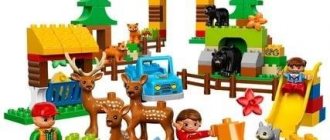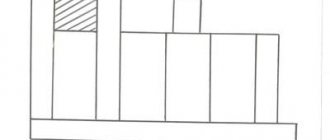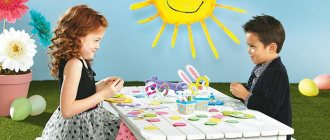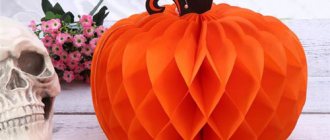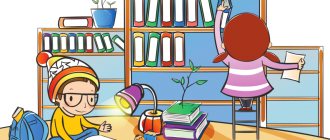Methods of teaching preschoolers to design from building materials (p. 1)
Methods of teaching preschoolers to design from building materials.
Design has wide possibilities for mental, moral, aesthetic, and labor education. With properly organized activities, children learn not only to construct individual objects from building materials (houses, cars, towers, etc.), but also acquire generalized skills - purposefully examining objects, comparing them, seeing what is common and different in them, finding parts from of which it consists, draw conclusions and generalizations. It is important that children’s thinking in the process of constructive activity has a practical orientation and is creative in nature. When learning to design, planning mental activity develops, i.e., children, when constructing a building or craft, mentally imagine and plan in advance how they will be performed and in what sequence.
Design also promotes knowledge of the properties of geometric bodies in practice; Children’s speech is enriched with new concepts (bar, cube, pyramid, high - low, narrow - wide, long - short, large - small). Constructive activity is a means of moral education of children, because in the process of this activity such qualities as independence, hard work, initiative, perseverance in achieving goals, and organization are formed. Collective buildings play a big role in developing the initial skills of working in a team - the ability to negotiate and work together without interfering with each other.
Construction is an obligatory component of the development of a child’s basic and creative abilities, the most important means of mental, artistic and aesthetic development and moral education.
The sample preschool education program “From Birth to School” sets the goals of gradually developing children’s constructive skills and abilities, taking into account their age-related capabilities; development of fantasy and imagination, creative thinking; nurturing independence, activity, friendliness, curiosity, accuracy, hard work and other important personal qualities. These tasks are solved both in class and when organizing constructive activities in free time and during games. In each age group, the psychological characteristics of children are revealed, which must be taken into account when organizing methodological work; the types of design are determined depending on the material used, the content of the work and detailed methodological recommendations for its implementation are given.
Ensuring the comprehensive development of children in the process of constructive activities, the teacher forms in them vital skills and abilities, reveals and develops potential capabilities, organizes work so that the children gain confidence in their abilities, strive to create something beautiful, looking at the world around them through the eyes of an artist; felt important, skillful, capable and talented.
First junior group
While playing with tabletop and floor building materials, continue to familiarize children with the details (cube, brick, triangular prism, plate, cylinder), with options for arranging building forms on a plane.
Continue to teach children how to build basic buildings based on a model, to support the desire to build something on their own.
Promote understanding of spatial relationships.
Learn to use additional story toys commensurate with the scale of the buildings (small cars for small garages, etc.). At the end of the game, teach the child to put everything back in its place.
Introduce children to the simplest plastic construction sets.
Learn to design turrets, houses, cars together with an adult. Support children's desire to build on their own.
In the summer, encourage construction games using natural materials (sand, water, acorns, pebbles, etc.).
By the end of the year, children can
• Distinguish between the basic shapes of building material parts.
• With the help of an adult, build a variety of buildings,
using most forms.
• Build the game around your own building.
Second junior group
Lead children to the simplest analysis of created buildings. Improve constructive skills, learn to distinguish, name and use basic building parts (cubes, bricks, plates, cylinders, triangular prisms), construct new buildings using previously acquired skills (laying, attaching, applying), use parts of different colors in buildings. Instill a feeling of joy at a successful construction.
Learn to place bricks and plates vertically (in a row, in a circle, around the perimeter of a quadrangle), place them close to each other, at a certain distance (fence, gate). Encourage children to create design options by adding other details (put triangular prisms on the gate posts, cubes next to the posts, etc.). Learn to change buildings in two ways: replacing some parts with others or building them up in height and length (low and high tower, short and long train).
Develop a desire to build buildings according to your own design.
Continue to teach how to play with buildings, combine them according to the plot: path and houses - street; table, chair, sofa - furniture for dolls.
After playing, teach children to carefully put the parts in boxes.
By the end of the year, children can
• Know, name and correctly use building material parts.
• Place bricks and plates vertically.
• Change buildings by adding on or replacing some parts with others.
Middle group
Draw children's attention to various buildings and structures around the kindergarten. On walks and during games, look at cars, carts, buses and other types of transport with children, highlighting their parts, name the shape of the parts and their location in relation to the largest part.
Continue to develop in children the ability to distinguish and name construction parts (cube, plate, brick, block); learn to use them taking into account their structural properties (stability, shape, size). Develop the ability to establish associative connections by asking them to remember what similar structures children have seen.
Learn to analyze a building sample: identify the main parts, distinguish and correlate them by size and shape, establish the spatial arrangement of these parts relative to each other (in houses - walls, at the top - ceiling, roof; in a car - cabin, body, etc.) .
Learn to independently measure buildings (in height, length and width), to follow the design principle given by the teacher (“Build the same house, but tall”).
Learn to build buildings from large and small building materials, use parts of different colors to create and decorate buildings.
Teach paper construction: bend a rectangular sheet of paper in half, matching the sides and corners (album, flags, greeting card), glue parts to the main shape (windows, doors, pipes to a house; wheels to a bus; back to a chair).
Involve children in making crafts from natural materials: bark, branches, leaves, cones, chestnuts, nut shells, straw (boats, hedgehogs, etc.). Learn to use glue and plasticine to secure parts; use reels, boxes of different sizes and other items in crafts.
By the end of the year, children can
• Use building parts taking into account their structural properties.
• Convert buildings according to the task.
• Fold a rectangular piece of paper in half.
Senior group
Continue to develop children’s ability to establish connections between the buildings they create and what they see in life around them; create a variety of buildings and structures (houses, sports and play equipment, etc.).
Learn to identify the main parts and characteristic details of structures.
Encourage independence, creativity, initiative, and friendliness.
Help analyze crafts and buildings made by the teacher; Based on the analysis, find constructive solutions and plan the creation of your own building.
Introduce new parts: plates, bars, cylinders, cones of various shapes and sizes, etc.
Learn to replace some parts with others.
To develop the ability to create buildings of different sizes and designs of the same object.
Learn to build according to a drawing, select the necessary building material yourself.
Continue to develop the ability to work collectively, combine your crafts in accordance with a common plan, and agree on who will do what part of the work.
By the end of the year, children should be able to
• Analyze a sample building.
• Plan the stages of creating your own building, find constructive solutions.
• Create buildings according to a drawing.
• Work collectively.
Improve the ability to work with paper: bend the sheet four times in different directions; work according to the finished pattern (hat, boat, house, wallet).
Learn to create three-dimensional shapes from paper: divide a square sheet into several equal parts, smooth out the folds, cut along the folds (house, basket, cube).
Continue to teach how to make toys, souvenirs from natural materials (cones, branches, berries) and other materials (spools, colored wire, empty boxes, etc.), firmly connecting the parts.
Develop the ability to independently make toys for role-playing games (flags, bags, hats, napkins, etc.); souvenirs for parents and kindergarten staff; Christmas tree decorations.
Involve in the production of manuals for classes and independent activities (boxes, counting material), repair of books, and printed board games. Develop creative imagination and artistic taste.
Teach children to use materials economically and rationally.
Preparatory group for school
To develop interest in a variety of buildings and structures (residential buildings, theaters, etc.).
Encourage the desire to convey their characteristics in constructive activities.
Learn to see the design of an object and analyze its main parts and their functional purpose.
Invite children to independently find individual constructive solutions based on an analysis of existing structures.
Strengthen teamwork skills: the ability to distribute responsibilities, work in accordance with a common plan, without interfering with each other.
| Due to its large volume, this material is placed on several pages: 1 |
Get text
